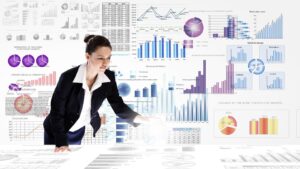In today’s data-driven world, business analytics and information systems have become the backbone of successful enterprises. They’re the secret weapons that give companies the competitive edge, transforming raw data into actionable insights.
So, whether you’re a seasoned business professional, an aspiring entrepreneur, or just curious about the world of data, you’re in the right place. Let’s delve into the fascinating realm of business analytics and information systems.
Business Analytics and Information Systems
 Business analytics and information systems aren’t merely buzzwords, they’re crucial cogs in the modern business machine. Business analytics covers methods and practices, including statistical analysis, predictive modeling, and quantitative methods, converting raw data into valuable insights. Thus it allows businesses to make informed decisions geared towards growth and improvement.
Business analytics and information systems aren’t merely buzzwords, they’re crucial cogs in the modern business machine. Business analytics covers methods and practices, including statistical analysis, predictive modeling, and quantitative methods, converting raw data into valuable insights. Thus it allows businesses to make informed decisions geared towards growth and improvement.
In contrast, information systems facilitate the collection, filtering, processing, creation, and distribution of data. This digital endeavor aids companies in organizing and processing vast quantities of data to uncover patterns and trends, thus enhancing decision-making processes. These systems, often electronic, offer a combination of software, hardware, data, and procedures, designed explicitly for data handling. In essence, the two concepts work in conjunction to enable businesses to intelligently navigate the data-driven world. They combine to not just simplify, but to revolutionize the way businesses interpret data and strategize.
Many companies, specifically in San Francisc,o rely on professional IT services in the Bay Area to implement and manage these systems effectively, ensuring the technology supports their goals and scales with growth.
Understanding Business Analytics
 Drawing a link from the prior exploration of business analytics and information systems, business analytics stands as a strategic asset for data interpretation. It aids businesses in exploiting data. It’s not just about crunching numbers; at its core, business analytics signifies a methodology to appreciate the narrative behind volumes of data, revealing insights that enhance business decisions. It firmly roots itself within three principal areas: descriptive analysis offering a perspective of past business performances, predictive analysis foreseeing future probabilities, and prescriptive analysis suggesting certain pathways based on the data outcomes.
Drawing a link from the prior exploration of business analytics and information systems, business analytics stands as a strategic asset for data interpretation. It aids businesses in exploiting data. It’s not just about crunching numbers; at its core, business analytics signifies a methodology to appreciate the narrative behind volumes of data, revealing insights that enhance business decisions. It firmly roots itself within three principal areas: descriptive analysis offering a perspective of past business performances, predictive analysis foreseeing future probabilities, and prescriptive analysis suggesting certain pathways based on the data outcomes.
In essence, comprehensive business analytics accelerates an organization’s capacity to process data, detect patterns, and unravel substantial trends, thus, channeling strategic planning and decision making. Emphasizing its capacity to glean data and drive informed decisions, it’s unmistakable that business analytics provides an edge in a competitive landscape. Future sections will delve further into the relationship between business analytics and information systems, illustrating how they coalesce to serve a critical role in modern business success.
Exploring Information Systems
 Information Systems serve as powerful conduits for organization and distribution of data in businesses. Acting as interfaces that streamline data communication, these systems abet businesses in decoding complex data structures. Two primary areas they specialize in include Data Management systems, handling data organization, and Communication Networks systems, facilitating data sharing. For instance, Database Management Systems (DBMS), categorizes, stores, and retrieves data while maintaining security measures. Meanwhile, communication networks enable data’s swift transit, connecting different parts of an organization. With seamless integration of business analytics, these systems foster easeful data interpretation, leading to richer insights. The subsequent sections delve deeper into the underlying functions and benefits of these information systems, setting a broader context for understanding the analytical proficiencies they bring to modern businesses.
Information Systems serve as powerful conduits for organization and distribution of data in businesses. Acting as interfaces that streamline data communication, these systems abet businesses in decoding complex data structures. Two primary areas they specialize in include Data Management systems, handling data organization, and Communication Networks systems, facilitating data sharing. For instance, Database Management Systems (DBMS), categorizes, stores, and retrieves data while maintaining security measures. Meanwhile, communication networks enable data’s swift transit, connecting different parts of an organization. With seamless integration of business analytics, these systems foster easeful data interpretation, leading to richer insights. The subsequent sections delve deeper into the underlying functions and benefits of these information systems, setting a broader context for understanding the analytical proficiencies they bring to modern businesses.
Integrating Business Analytics with Information Systems
So, we’ve seen how business analytics and information systems are game-changers in today’s data-driven business landscape. They’re not just tools; they’re strategic assets that transform raw data into valuable insights, driving growth and innovation. Business analytics, with its triad of descriptive, predictive, and prescriptive analysis, unravels the stories behind numbers, empowering businesses to make data-driven decisions. On the other hand, information systems, particularly Data Management Systems and Communication Networks, act as the backbone of data organization and distribution, making sense of complex data structures.
When integrated, business analytics and information systems create a powerful synergy that revolutionizes data interpretation, leading to richer insights and a competitive edge. Whether you’re a business professional, an aspiring entrepreneur, or just intrigued by the role of data in modern business operations, understanding and harnessing this synergy is key to succeeding in the digital age.



